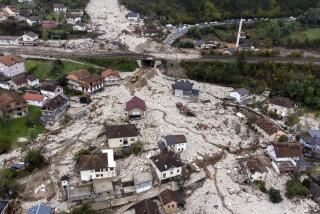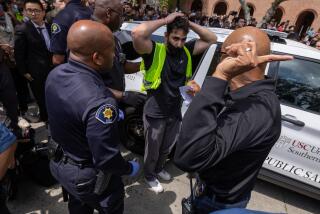Officials Probe Suspected Mass Graves in Bosnia
- Share via
SAHINICI, Bosnia-Herzegovina — A team of six United Nations investigators, wearing rubber gloves and wielding cameras, began the long-awaited, potentially explosive work of studying suspected mass grave sites in Bosnia’s Drina River valley on Wednesday.
The investigators spent the entire day working in a single muddy field, about the size of a high school gym, setting up numbered markers next to bone fragments, articles of clothing and other evidence of a horrific slaughter believed to have taken place in nearby woods and fields eight months ago.
Human bones--including one nearly complete skeleton--were plainly visible lying on top of the soil near the brushy edges of the field, where the ground’s surface was undisturbed. But the bare earth in the middle of the field had obviously been dug up before the investigators got here.
“We haven’t changed anything here,” said John Gerns, an American member of the team, when asked how the field looked when his colleagues arrived. Where he was working, the earth lay in mounds and open furrows, as if large objects had been dug up and removed.
The U.N. investigators were unwilling to describe any aspect of their techniques or findings so far. Over the course of the day, they placed about 50 yellow plastic markers on pieces of evidence in the field, then photographed each numbered piece up close. They also put a simple barrier of yellow tape around the field--enough to keep out ordinary passersby but certainly nothing to prevent further evidence-tampering.
As many as 8,000 fighting-age Muslim men have been unaccounted for since the former U.N. “safe area” of Srebrenica fell to Bosnian Serb forces in July. The men, most of whose weapons had been taken away in the U.N.’s attempt to pacify the area, tried to flee the well-armed Serbs.
According to survivors, the men were gunned down in the woods, and in many cases taken alive to collection centers and executed.
Survivors have told chilling tales of watching friends and neighbors being forced to dig their own graves, then stand at the edge and be gunned down, much as victims of the Nazis were made to do during the Holocaust. If such testimonies can be confirmed, the Srebrenica massacres would be among the worst atrocities in Europe since World War II.
Wednesday’s effort in the field outside Sahinici represents the first step in a slow, methodical process of corroborating the survivors’ accounts and documenting precisely what happened to the missing. Similar work is scheduled to take place at half a dozen other suspected mass graves in the area in coming weeks.
Military intelligence indicates there may be at least five times that many mass graves running along an 11-mile stretch of the Drina River, which flows between the rump Yugoslavia and the Serbian part of Bosnia-Herzegovina.
Evidence collected in the cornfields and rolling farmlands of the Drina valley will be sent to the International Criminal Tribunal for the Former Yugoslavia at The Hague, which is trying to identify and prosecute those responsible for the worst atrocities of the Balkan war. Tribunal officials say their work is central to bringing peace to the former Yugoslav federation: They hope that by singling out the guilty from ordinary citizens, they can help cool down the generalized climate of hatred and distrust here.
“We’ll never have peace before there’s reconciliation on both sides, and this is part of that process,” said Col. John Batiste, commander of the 1st Armored Division’s 2nd Brigade, which has soldiers and fighting vehicles a stone’s throw from the investigators. The U.S. Army is providing limited assistance to the investigators, lodging them at a base in the region and standing by with fighting vehicles in case any opponent of the researchers should stage an attack.
The Army is not guarding the suspected mass graves overnight, however, leaving opponents of the U.N. investigation ample time to bulldoze the remains away.
While the research proceeded in Sahinici, wives and other relatives of the missing men, now living as refugees in the nearby city of Tuzla, expressed little hope that the investigation will lead to justice.
“This is all just a game,” said Saha Mustafic, 41, who stood with her knitting in the yard of a Tuzla school that has been turned into a collection center for refugees from Srebrenica. “If they wanted, they could have done everything already.”
Mustafic, who lost her husband, brother and two nephews in the fall of Srebrenica, said it is difficult for her to see any difference between the American and other foreign peace enforcers now patrolling her homeland, and the unsuccessful U.N. peacekeeping mission that preceded them.
“They delivered us for slaughtering,” she said of the U.N. peacekeepers in Srebrenica, who stood by without firing a shot when Serbian forces overran the city.
More to Read
Sign up for Essential California
The most important California stories and recommendations in your inbox every morning.
You may occasionally receive promotional content from the Los Angeles Times.










